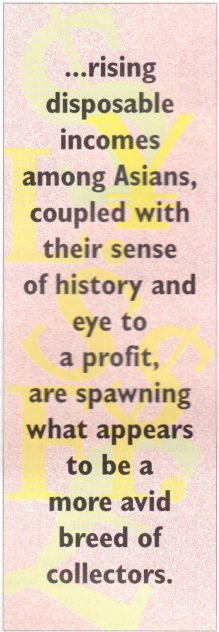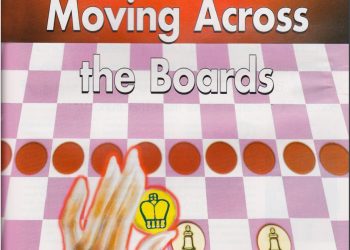If recent auctions in Singapore and Hong Kong are any guide, Asian collectors are growing increasingly enthusiastic about rare coins and banknotes.
INTEREST IN ASIAN PIECes in particular, experts say, is going through a boom. At a recent sale in Singapore held by London art dealers Spink & Son, the highest price in the banknote section was a hefty US$70,800 for a set of four old Malaysian currency notes. Total sales at that auction, Singapore’s second, reached US$1.2m, topping the $1m achieved at Spink’s first Hong Kong sale last November. In Hong Kong the top lot among banknotes was two 1866 Oriental Bank Corporation notes. They sold for US$60,000. At the same sale, a rare undated late Qing Dynasty Chekiang silver dollar sold for US$57,100. For a single coin!
Barnaby Faull, Spink’s Bank- note Department director, said after the Hong Kong sale that the market was ‘clearly very hungry’ for rare and top quality pieces difficult to find in Asia. Spink will stage its second Hong Kong auction in November.
Particularly sought after right now is anything to do with the early history of the Straits, Singapore and Hong Kong as well as notes or propaganda issued during war time.
‘Rarity is one of the key factors driving the market because coins and medals from this part of the world are rare,’ says Richard Bishop, another Spink director.
‘But quality all over the world sells. If you have a quality piece, it doesn’t matter what country it’s from, when you come to sell that piece you will always get a good price.”
Why the interest? For a start, collecting money is nothing new people have been doing it for centuries.
But rising disposable incomes among Asians, coupled with their sense of history and eye to a profit, are spawning what appears to be a more avid breed of collectors.
And cost-wise, coins and notes may be a more accessible collectible than say, paintings or jewelry. The sky-high prices paid for the top lots at auctions involve the very rarest of pieces.
In the market for banknotes, which tend to fetch more than coins, the mere fact that prices have been shooting up recently also guarantees interest. Faull puts these rises down to the fact that more collectors mean fewer notes.
He says the market is 99% collector-driven. That makes it healthier than other fickle investment markets and less prone to wild swings and downturns.
“When you have an investment market people tend to pull their money out when the market goes down and prices go down,’ he says.
‘A collector will put his life into collecting, whether it’s jade, pictures or banknotes and he will be reluctant to sell- he would rather starve sometimes than sell his collection.
‘ Visit a coin and note dealer in any Asian city and you’ll find colorful banknotes from around the globe, pieces of metal used as money by warring dynasties in China and a vast array of coins commemorating everything from the Olympic Games to Royal Tours.
Not all interest centers on old pieces. Some dealers specialize in gold or silver coins freshly minted by various governments. Collectors buy these now with a view to making a profit in years to come. “Today’s issue is tomorrow’s antique,’ says Lim Beng Haw of Taisei Stamps & Coins in Singapore.
What makes a coin or note rise in value? Apart from rarity, the quality of the piece is vital. It should be in the best condition possible and in Asia’s climate that is not easy to achieve.
Strength of domestic demand is also important. For example, a note from England, Hong Kong or Singapore will fetch a lot more than one from Romania or Albania because there is little demand from collectors in the latter countries.
With coins, gold is obviously valuable more than silver and silver more than copper. As an example of how gold can rise in value, Singapore’s first gold coin, issued in 1969 at 88250, is today worth $85,000-a 20-fold appreciation.
But silver coins can still be worth a lot. US Silver Dollars issued in 1804 are now worth US$1m each despite the fact that the silver is worth less than US85.
Predicting how much a coin or note will appreciate is difficult. Ram Naidu of the Singha Banknotes Society says he bought a pair of King George VI Commonwealth Notes issued in 1942 for US$1,200 from a collector who paid about $1060 two years earlier.
Some notes and coins have no value at all if they are forged. One

of the most impor- tant warnings a potential collector should heed is to be sure of their source.
Bishop’s advice is to ask yourself who you are buy- ing from. ‘If you’re buying from some- one you don’t know and it’s very cheap you should naturally be cautious,’ he says. Reputable dealers provide guarantees -members of the International Professional Numismatic Association must guarantee a coin for life-so that if a piece turns out to be a forgery, you get your money back. The best protection, he says, is to know our source.
If you plan to start collecting seriously:-
■Attend an auction. Even if you don’t buy, the sales will still give you an idea of market values. And that, according to Ram, will be useful for judging the fairness of prices charged by dealers outside.
■Talk to dealers and fellow collectors during your initial stages of research. Learn the history of Asian money.
■Maintain your coins and notes properly otherwise their value may suffer. Keep them in dry places, away from air conditioning and in plastic folders free of acids. Be patient for any financial gain. They rarely occur overnight.



